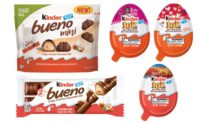Demand for chocolate in snack and bakery items is driven by two core consumers: Luxury seekers; and healthy snack eaters who both share a common desire for great-tasting chocolate produced in a sustainable fashion.
According to market research from Mintel, chocolate has fared seemingly well in a lagging economy, growing 19% in sales from 2007 to 2012, and forecasts for the future are just as encouraging. Mintel’s research shows that the category is positioned to grow 15% through 2017. The firm attributes this growth to consumer demand for affordable luxuries and indulgences, as well as the emergence of a foodie culture that places a high value on premium, high-quality and artisanal chocolate.
“There will always be a demand for indulgent and premium bakery and snack products,” says Courtney LeDrew, marketing manager at Cargill Cocoa & Chocolate, Lititz, PA. “As an affordable luxury, premium items are one way for consumers to treat themselves. In addition, consumers are experience-driven; they’re willing to try new things, and they actively seek out exciting and intense flavor pairings and new textures.”
It makes sense that dark chocolate is gaining in popularity, as more consumers take note of the premium that comes with a high cocoa percentage. In fact, Mintel found that 35% of shoppers favored dark chocolate (a percentage gaining traction on the 51% of consumers who favored milk chocolate). And in the 55-and-older consumer set, dark chocolate led the way, at 46% of men and 48% of women favoring this variety; just 38% of men and 40% of women favored milk chocolate. As an added bonus, 73% of all chocolate consumers are aware that dark chocolate is healthier, another possible explanation for the variety’s surging popularity.
“As the economy recovers ever so slowly, consumer demand for the affordable indulgence that chocolate provides is expected to remain, and interest in chocolate as part of the larger food culture will continue,” notes Sarah Day Levesque, food analyst at Mintel. “However, obesity, the dark cloud that looms over this category and many other indulgent categories, and its related health risks, will remain a concern for many consumers and present challenges to increasing category sales.”
The rising popularity of dark chocolate is also a microcosm of consumer demands of the chocolate industry as a whole: When it comes to chocolate, people are looking for a snack or baked item that’s healthier and, at the same time, elevated and even exclusive.
Demand for the decadent
“Consumers are looking for more premium and decadent items, and unique flavors and inclusions, which is creating excitement within the baked goods and snacks category,” explains Laura Bergan, senior marketing manager at Barry Callebaut, Chicago. As such, chocolate is a perfect fit, she says.
And according to Rose Potts, corporate manager of sensory and product guidance at Blommer Chocolate, Chicago, the millennial mentality has a lot to do with the way luxury is perceived. “Millennials crave variety and aren’t particularly brand loyal,” she adds, “so you have to create that curiosity on the shelf.”
One way Potts recommends that manufacturers pique interest is through seasonal and limited-edition varieties, or offering new and unexpected compound coating flavors, like chili lime or mango and toasted coconut. To keep things fresh and exciting, Blommer Chocolate offers coating and chip flavors like butterscotch, cappuccino drops, chocolate chili, red apple, banana and salted caramel. These can be used as coatings on salty snacks, for enrobing baked goods or as inclusions, says Potts.
“A growing trend within [the chocolate and cocoa category] is the increasing demand for more customized, seasonal and limited-time offerings,” agrees Bergan. “Unique offerings such as trendy flavors, colors or uniquely textured inclusions provide the consumer excitement within these categories.”
Barry Callebaut recently launched a Greek yogurt portfolio, tapping into not only a trendy ingredient profile, but also the added health implications that come with Greek yogurt. It’s appropriate to enrobe or top applications like chocolate snacks, bars and bakery items.
A blast of intensity
Meeting the demand for premium chocolate offerings is Puratos Corp., Cherry Hill, NJ, with its Belcolade Origins chocolate line. “Each Belcolade Origins chocolate is made with carefully selected cocoa beans that are unique,” says Jessica Blondeel, product manager, SBU chocolate. “They reflect the differences of the regions where they are grown.”
The line’s latest addition to this portfolio is the Belcolade Origin Vietnam 73, a dark chocolate with a 73% cocoa content. “This chocolate has an unexpected taste,” Blondeel adds, “a pronounced acid cocoa taste, enriched with citrus, wood and tobacco notes.”
“Current trends within the cocoa industry include products that incorporate more intense and indulgent cocoa flavors,” agrees Kathy Koszuta, marketing services specialist at ADM Cocoa, Milwaukee. The company recently expanded its cocoa powder offerings to include deZaan D11SQ cocoa powder, which offers a deep cocoa taste and appears dark brown in color to complement the flavor intensity.
But this isn’t the only trend dominating the chocolate and cocoa ingredient market. Puratos conducted extensive consumer behavior global research through its Taste Tomorrow platform, which involved interviewing 6,400 consumers worldwide about their attitudes and preferences. One megatrend the company identified is the consumer decision between pleasure and health. Consumers who indulge in smaller portions may see their snack as a treat, and therefore demand luxury as their first priority. Conversely, shoppers who indulge frequently are more conscious of calorie counts and health profiles of the products they’re ingesting and may prioritize a product’s label above all.
Healthy benefits
“Consumers are increasingly looking for products that are healthy and clean-label, without having to cut back on taste,” explains Blondeel. “This can be translated into nongenetically modified (GMO) products, products with a high level of antioxidants, gluten-free chocolate or protein-enriched chocolate.”
LeDrew concurs: “Nutritive claims are important because consumers want to be able to indulge while doing something good for their health. Protein is gaining interest, and it’s at the convergence of a number of food trends including healthy snacking, weight management, sports nutrition and producing food targeted toward aging adults in the U.S. Chocolate offers a great way to mask the flavors of added nutrients. As a result, there are many opportunities for innovative, fortified confectionery coatings that help contribute to a nutrient content claim for protein.”
Cargill Cocoa & Chocolate offers four Wilbur protein products suitable for a variety of bakery and snack applications: Wilbur Y854 cocoa confectionary protein wafers and Wilbur Y855 milk confectionery protein wafers are each formulated with 20% total protein; Wilbur Y938 white chocolate protein drops boast 10% total protein; and Wilbur Y958 cocoa confectionery protein drops have 25% protein. “Wilbur protein coatings and inclusions can be used to enrobe, drizzle or bottom nutrition or snack bars,” says LeDrew. “In addition to using any of the Wilbur protein products in snack bars, the protein drops can be added to cookies, muffins, breads, snack mixes or any other bakery application where increased protein levels are desired.”
Also appealing to health-conscious manufacturers is the fact that Wilbur W753 white confectionery wafer, Wilbur W754 cocoa confectionery wafer and Wilbur W755 dark confectionery wafer compound coatings are made without hydrogenated oil.
Sustainable sweetness
Sustainability is increasingly important in the chocolate industry, as it appeals especially to the two core chocolate consumers: Health-conscious shoppers who prioritize the health of the environment; and luxury-seekers who are willing to pay a little extra to ensure the proper treatment of farmers.
“To contribute to a better cocoa economy, Puratos has created its own cocoa farmers program and internal certification called Cacao-Trace,” Blondeel explains. One example of this program at work has been in Vietnam, where the company purchases high-quality cacao pods directly from farmers and rewards their efforts with a price premium, empowering them to improve their income and livelihood. The company estimates that 36% of this premium is being reinvested by farmers to increase yield and quality.
“By educating farmers, we help them boost the productivity of their farm and the quality of their cacao,” Blondeel adds. Belcolade Origin Vietnam 73 is a product of this program.
Barry Callebaut has prioritized sustainable cocoa for more than 20 years, explains Bergan, and has its own programs in the cocoa-growing regions that focus solely on sustainable cocoa and direct connections with the farmers who grow it. “The focus includes farmer training, farmer education and farmer health,” she says. “The goal is to grow more and higher quality cocoa, while providing the farmers and their families with increased income due to additional yields, education for women and children, with improved access to health care.”
ADM Cocoa’s sustainability program, SERAP (Socially and Environmentally Responsible Agriculture Practices), reaches more than 60,000 farmers throughout Côte d’Ivoire, Nigeria and Indonesia. “The program started in Côte d’Ivoire and was solely focused on reaching farmers through existing cooperatives,” explains Koszuta. “Since then, the program has expanded, both regionally and in how we work with farmers. We now reach out to independent cocoa growers through the creation of organizational structures like farmer clubs or by using existing commercial structures to efficiently reach those no-coop-organized farmers.” SERAP’s holistic approach allows the company to add new elements to the platform as needed, such as women empowerment and family nutrition programs.
The Cargill Cocoa Promise is one way that Cargill expresses its commitment to improving the livelihoods of farmers, their families and their communities, while also securing a long-term supply of the ingredient. The program was introduced in 2012 to align Cargill’s efforts in six origin countries in three key areas: Farmer training; community support; and farm development.
“With regard to farmer training, our ambition is to provide all the farmers with whom we work the knowledge, skills and support to increase the productivity and profitability of their farms in a responsible and sustainable way,” LeDrew explains. “Our goal around community support is to strengthen cocoa-growing communities and promote social development by ensuring access to basic services, such as education and healthcare. Lastly, we’re focusing on supplying small-holder farmers with the knowledge, input and financing they need to make good decisions and run a successful farm over the long-term to support farm development.”
Cargill Cocoa & Chocolate has also increased the range and availability of its certified sustainable cocoa and chocolate products for customers in North America. Gerkens cocoa powders, as well as Peter’s, Wilbur and Veliche chocolate brands are available with certification options including Rainforest Alliance Certified, Fair Trade USA and more.
“The demand for cocoa is soaring, with some estimates that global demand for cocoa will outweigh supply by 1 million tons by 2020—this is one of the largest challenges in the industry,” LeDrew says. “As supplies of cocoa beans become increasingly difficult to secure, it’s vital that we take a long-term view on how we source quality products, as well as address issues in the supply chain, including farm productivity, bean quality, improving agricultural practices and tackling pests and diseases.”
The Cargill Cocoa Promise will help farmers get a better yield and income, provide them a pathway to certification and provide Cargill with an available volume of certified beans and products, she says. “We’re confident we’re heading in the right direction to not only deliver products to meet our customers’ commitments, but also to support a sustainable long-term cocoa supply chain.”








